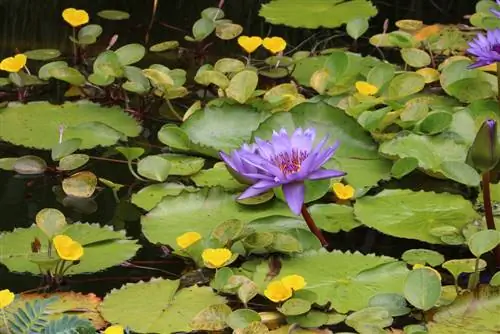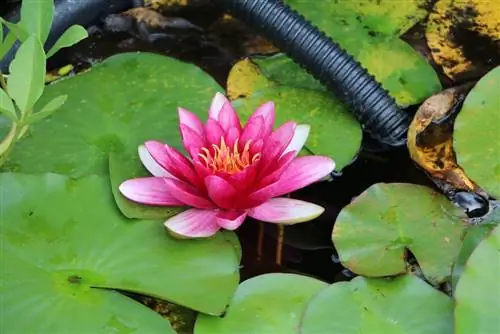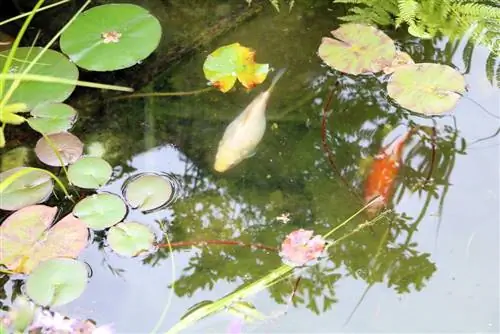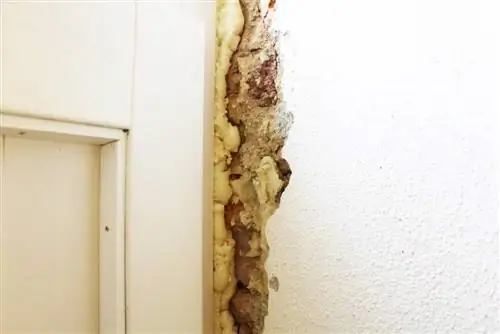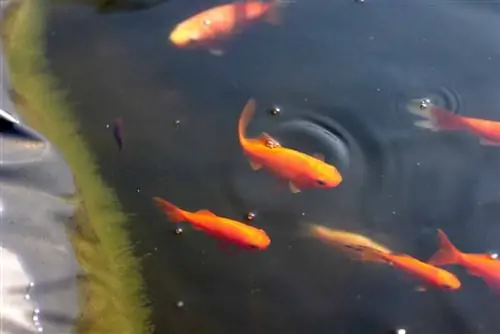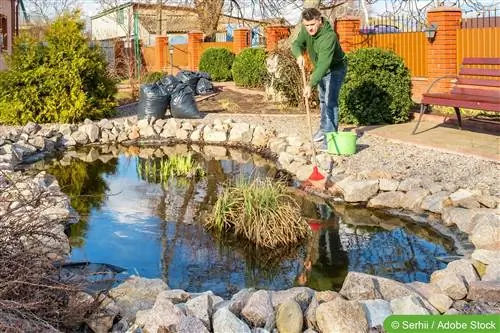- Author admin [email protected].
- Public 2023-12-17 03:39.
- Last modified 2025-01-24 12:45.
Garden owners love their beautiful pond, which, when well maintained, is the flagship of the garden. However, everyone who owns a pond knows that maintaining the pond requires a lot of work. The garden pond must be constantly cleaned and maintained. The quality of the water must be checked and the pumps must be serviced at regular intervals. And of course the fish inside have to be fed.
But even in properly maintained and lovingly cared for ponds, foam can form. This foam is primarily ugly and annoying. It only represents a visual problem. The foam on the garden pond does not pose any danger. But how does the knotty foam formation occur and what can you do about it?
The causes of foam on the garden pond
The formation of foam on moving bodies of water is a natural process. Even with sea water, the movement of the water creates spray, which is visible to everyone on the surface of the water. So-called foam ridges can arise when there is surf. This is desired and is viewed as positive for the sea. Even in a pond, whitecaps are not a sign that the water has turned over. On the contrary, low foam formation indicates optimal water composition. So if there is a little foam on the pond, it just means that the chemical and biological processes are taking place as desired. The foam formation also depends on how much the water is moved. The more the water is stirred up, the more foam is formed.
If undesirable foam formation occurs, it is not always just because the water is being stirred up too much. Increased foam formation can always have several causes. These causes are usually of natural origin, unless surfactants from soaps or detergents have gotten into the pond water. In most cases, excessive foaming occurs when the protein content in the water is too high. One reason for the increased protein production may be the production of spawn by the fish in the pond. Another reason may be that material is rotting at the bottom of the pond. This material includes not only foliage and leaves, but also deceased fish. But an increased proportion of algae can also cause the protein content in the water to increase and the water to foam more than usual. In addition to these natural causes, the surfactants already mentioned can also lead to increased foam formation. These do not necessarily have to get into the water via detergent.
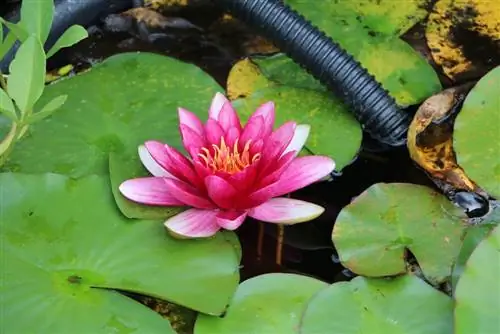
Over-fertilization of plants near the bank can also cause it to get into the water and cause foam to form. Over-fertilization usually leads to increased growth of algae, which then causes the foam. But increased phosphate or nitrate levels can also cause foaming. The reason for this usually lies in the agricultural use of neighboring properties. If natural and chemical causes have been ruled out, the filter systems should be checked. If the filters are installed above the water surface, more air gets into the water, which leads to foam formation. But fountains or waterfalls also cause foam. The water values should also be checked. In addition, too much fish droppings, animal corpses on the bottom of the pond and calcareous stones can also cause foaming. Saponins can also be the cause of undesirable foam formation. Saponins are added to some types of fish food. These also foam up natural bodies of water such as rivers or streams in spring. The saponins accelerate the growth of the fish, but they also cause the water to foam up unpleasantly. If no other cause is possible, the composition of the fish food could be the cause of the unwanted foam on your garden pond at home.
What can be done to prevent foam formation?
It is important to find out the cause of the foam. If this remains unclarified, the visual problem can occur again and again, even if the foam has been removed for a short time. It should also be in the interest of the pond owner to clarify whether foam formation is due to a natural cause or whether toxic surfactants have gotten into the water. If this is the case, the poisoning caused by the surfactants not only affects the water, but also the fish that are in it. First of all, you should use a simple test from a specialist retailer to check whether the water values are OK. If this is not the case, the water should be changed. If the contamination comes from the surrounding area, the inflows must be stopped or the banks must be raised higher. If the cause is rotting material, the pond should be cleaned of mud and leaves at the bottom.
Foaming that is of natural origin but which recurs repeatedly can be treated mechanically. In such cases, foam traps can be used. They hold the foam so that it can be skimmed off. However, protein skimmers can also be used. These are installed in the pond pumps. The protein skimmers not only remove proteins, but also other substances, including phosphates. They also reduce the growth of algae and can increase the oxygen content in the water. The module is therefore able to eliminate the symptoms, but does not combat the cause. Floating barriers help collect the foam near the inlets. It can be skimmed off here. In addition, care should not only be taken to ensure that the surrounding area is not over-fertilized, but the fish in the pond should also not be over-fed. The fish can usually feed on the plants that are in and on the water, algae and animals in the water.
Things to know about foam on the pond
The foam on the garden pond is a visual problem. He's not dangerous. This is flocculating protein. If the water in the pond moves (fountain, waterfall or similar), the excess protein begins to form foam. It is a natural process that can also be observed at the sea: you often see so-called foam ridges in the surf. A slight foam formation can even be seen as positive. It shows that the pond water is well composed and that the desired biological and chemical processes are taking place in it. The more the water is moved, the more foam forms.
Causes
- In most cases, foam formation occurs especially in the morning hours.
- This often happens in ponds where the filter system is installed above the water level.
- The water flowing back brings a lot of air into the pond.
- Waterfalls, streams or fountains can also cause the foam.
- You should definitely check the water values.
- It may well be that in new ponds or newly installed pumps the filters have not yet run in properly.
If there is too much protein in the water, this can have various causes. Protein is created by dead leaves, too much fish droppings, lots of pollen (spring), animal corpses, algae, dead pond plants and others. Limestone can also cause the water to foam. Another cause of foam formation are saponins. Saponins also cause natural bodies of water such as streams and rivers to foam, mainly in spring. Certain saponins influence the fish's hormonal system. Saponins are added to certain fish foods. They accelerate the growth of the fish. So you should take a close look at your fish food and see what ingredients it contains. If there are saponins in it, this can explain the foaming water.
Countermeasures
- You can use swimming barriers to hold the foam together at the inlets and skim it off occasionally.
- A suitable protein skimmer is ideal. This is built into the filter system.
However, the protein skimmer does not solve the cause: it removes proteins, proteins, phosphates and other substances from the water. It reduces algae growth and increases the oxygen content, so it does a lot for the pond.
- Otherwise, it is recommended to eliminate the protein sources.
- This includes leaves and plant remains,
- as well as the layer of mulch on the ground, which contains plant remains, fish droppings and other material.
You should also not feed the fish in the pond too much. They are said to feed on algae, plants and creatures living in and on the water!

